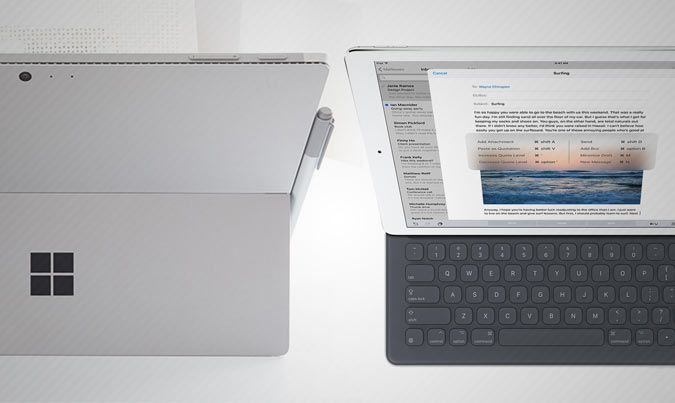The 2-in-1 Debate: Why Apple Is (Mostly) Wrong
Apple CEO Tim Cook has never been shy about bashing 2-in-1 devices, and this week he took a swipe at Microsoft's new Surface Book, which transforms from a full Windows laptop to a tablet. "It's a product that tries too hard to do too much," he said. "It's trying to be a tablet and a notebook and it really succeeds at being neither. It's sort of diluted."
As you might imagine, the Windows camp heartily disagrees. I shared Cook's quote with Mike Nash, vice president of customer experience for HP, which just launched a Surface competitor in the Spectre x2. "I can't tell the difference between what [Cook] is saying about Surface and what he's trying to do with iPad Pro. It seems like iPad Pro is trying to do that."
It's true that the iPad Pro has a $169 accessory keyboard that turns the tablet into a quasi 2-in-1, but it's not a full PC like the Spectre x2, Surface Pro, Surface Book and a large number of other Windows-powered hybrids. The iPad Pro is first and foremost a 12.9-inch tablet.
MORE: Surface Book vs. MacBook Pro
However, that doesn't mean comparisons between the iPad Pro and traditional laptops are completely unfair, especially since the iPad Pro costs $1,067 with its keyboard and Apple Pencil -- or about the same as a MacBook Air. Many have pointed out that the iPad Pro's keyboard doesn't have a touchpad for controlling the cursor, clicking on links, etc. Yes, you can reach out and touch the screen, but it's still annoying.
"Giving up the touchpad is a problem," Nash said. "Customers don't want to have to constantly reach up to do little navigational things. They don't want to feel like they've given things up. They want full travel. They want touchpad. They want a palm rest."
As Intel's chips powers the vast majority of Windows 2-in-1 devices, the company just doesn't share Apple's view. "We're seeing huge growth in the category, and I don't think that's because there's a bunch of dissatisfied users," said Karen Regis, Intel's mobile marketing manager. "We're seeing this huge year-over-year growth since we introduced the concept."
Sign up to receive The Snapshot, a free special dispatch from Laptop Mag, in your inbox.
Regis also shared that people are buying 2-in-1s out of want rather than out of need, and they're refreshing their purchases faster than the average consumer. 2-in-1 owners upgrade every 9 to 12 months, compared to a 3-to-4 year cycle for laptop users.
It's important to recognize that not all 2-in-1s are the same. Most fall into two camps right now: flip-around, convertible 360 devices like the Lenovo Yoga 900 and HP Spectre x360 and detachables like the Surface Pro. According to HP, 64 percent of convertible 360 hybrid owners prefer laptop mode, versus 56 percent for detachable owners.
In a way, the iPad Pro is a detachable with its keyboard, but its mobile operating system doesn't deliver the versatility of OS X or Windows when it comes to multitasking, even after iOS 9 introduced the ability to switch apps more quickly. Swiping in from the right or pressing Alt-Tab on the Smart Keyboard isn't as easy as just looking down at a dock and selecting an item.
The iPhone-like homescreen is also a missed opportunity given all of the real estate on the iPad Pro. There has to be something more useful Apple can dream up than just cramming more icons on the display. Even within apps there's a lot of wasted real estate. In Hipchat, for example, I can't see the list of rooms for chats once I'm within a room. I can see it all when I'm on my Mac. Hopefully, app developers will update their wares to optimize for the bigger iPad.
On the other hand, Windows hybrids aren't very compelling tablets right now, mostly due to a lack of high-quality apps that are optimized for touch and pen input. And that's where Apple is winning.
"There's a bit of a chicken and an egg problem there," Nash admitted. "Someone's gotta step up first to go cause the ecosystem to happen. To get this flywheel to work, it's easier to get critical mass by getting the hardware to come first, so I’m really committed to making sure we built a device that can handle the apps, even though the apps probably aren't where we want to be at yet."
There needs to be an ecosystem of so-called Universal apps that are compelling both in desktop and tablet mode, but developers are just getting started.
Ultimately, both Windows 2-in-1s and the iPad Pro deliver compromised experiences, but Windows is starting from a stronger position because there are less trade-offs in everyday usability. The iPad Pro could very well be successful in its own right, especially with creative types who take advantage of the $99 Apple Pencil that works with Apple's new tablet, but it's more of a niche device.
It's telling that when you purchase an iPad Pro from Apple online, you're asked whether you want an engraving before you get to a separate screen to add the keyboard. Apple is resisting the urge to converge tablets and laptops, even as it's offering options to get users closer to that type of experience. Microsoft is already there, but it needs to improve that experience to make 2-in-1s realize their full potential.


